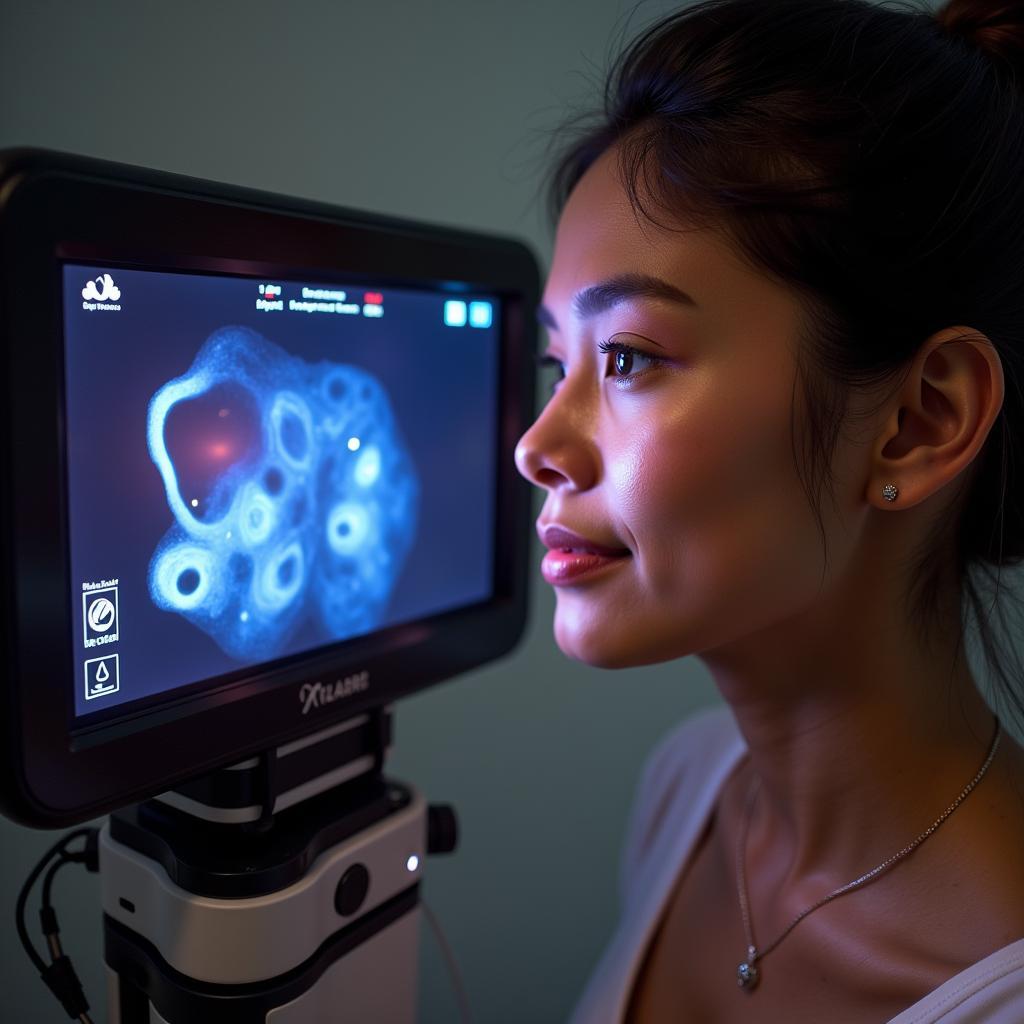Dermal Diagnostic Tools are becoming increasingly popular in the skincare industry, offering a non-invasive way to analyze skin health and address specific concerns. These tools utilize advanced technologies to provide a detailed assessment of the skin’s condition, going beyond what the naked eye can see. This comprehensive guide will delve into the different types of dermal diagnostic tools, their benefits, and how they can revolutionize your skincare routine.
What are Dermal Diagnostic Tools?
Dermal diagnostic tools are specialized devices designed to evaluate various aspects of skin health. They employ a range of technologies, such as imaging, spectroscopy, and bioelectrical impedance analysis, to capture and analyze data about the skin’s structure, function, and composition. By providing objective measurements and insights, these tools empower skincare professionals and individuals to make informed decisions regarding their skin health.
Types of Dermal Diagnostic Tools
1. Skin Analyzers with Imaging Technology
Skin analyzers equipped with imaging technology, often high-resolution cameras, capture detailed images of the skin’s surface and deeper layers. These images reveal:
- Wrinkles and fine lines: Assess the severity and location of wrinkles to determine the appropriate anti-aging treatments.
- Pigmentation irregularities: Identify areas of hyperpigmentation (sunspots, melasma) or hypopigmentation (loss of pigment) for targeted treatments.
- Pore size and texture: Analyze pore size and distribution to guide exfoliation and pore-minimizing solutions.
2. Spectrometers for Skin Composition Analysis
 Spectrometer for Skin Composition Analysis
Spectrometer for Skin Composition Analysis
Spectrometers utilize light to analyze the skin’s composition, revealing information about:
- Collagen and elastin levels: Assess the skin’s firmness and elasticity, providing insights into its aging process.
- Melanin content: Determine the skin’s natural pigment levels and susceptibility to sun damage.
- Hydration levels: Measure the moisture content of the skin to guide hydration strategies.
3. Bioelectrical Impedance Analysis (BIA) Devices
BIA devices use a weak electrical current to measure the body’s impedance, providing information about:
- Skin hydration levels: Assess the amount of water in the skin, indicating hydration status.
- Cellular activity: Analyze the health and activity of skin cells.
- Skin elasticity and firmness: Evaluate the skin’s ability to bounce back and resist deformation.
Benefits of Using Dermal Diagnostic Tools
Integrating dermal diagnostic tools into skincare routines offers numerous benefits:
- Personalized skincare: By providing detailed skin analysis, these tools enable tailored treatment plans that address specific concerns effectively.
- Objective measurements: Unlike subjective observations, these tools offer quantifiable data, allowing for accurate progress tracking and treatment adjustments.
- Early detection: Identifying potential skin issues in their early stages allows for proactive intervention and potentially better outcomes.
- Enhanced communication: These tools facilitate clear communication between skincare professionals and clients, fostering trust and understanding.
Choosing the Right Dermal Diagnostic Tool
Selecting the right dermal diagnostic tool depends on individual needs and goals. Consider the following factors:
- Specific skin concerns: Different tools excel in analyzing particular aspects of skin health.
- Budget and features: Tools vary in price and functionality; prioritize features aligned with specific requirements.
- Ease of use and interpretation: Opt for user-friendly devices with clear and understandable results.
Expert Insights
“Dermal diagnostic tools have revolutionized my practice,” says Dr. Emily Carter, a board-certified dermatologist. “They provide invaluable insights into my patients’ skin health, allowing me to develop highly personalized treatment plans that deliver exceptional results.”
Adding to this, renowned aesthetician, Sarah Williams, notes, “The ability to objectively measure skin parameters has transformed how I communicate with my clients. They can now see the improvements firsthand, which builds trust and encourages long-term commitment to their skincare journeys.”
Conclusion
Dermal diagnostic tools empower individuals and skincare professionals to take a data-driven approach to skincare. By providing a comprehensive understanding of the skin’s condition, these tools facilitate personalized treatments, early detection of potential issues, and ultimately, healthier and more radiant skin. If you’re seeking to optimize your skincare routine or explore the latest advancements in skin analysis, consider exploring the possibilities offered by dermal diagnostic tools.
Need expert advice on choosing the right dermal diagnostic tool for your needs? Contact ScanToolUS today at +1 (641) 206-8880 or visit our office at 1615 S Laramie Ave, Cicero, IL 60804, USA. Our team of experts is here to guide you towards healthier, more beautiful skin.
Frequently Asked Questions (FAQs)
- How often should I use a dermal diagnostic tool?
- The frequency depends on the specific tool and individual skin concerns. Consult with a skincare professional for personalized recommendations.
- Are dermal diagnostic tools suitable for all skin types?
- Most tools are designed to be safe and effective for various skin types. However, it’s crucial to inform your skincare provider about any specific skin conditions.
- Can I purchase a dermal diagnostic tool for home use?
- While some basic tools are available for home use, professional-grade devices offer more comprehensive analysis and are best utilized under expert guidance.
- How accurate are the results provided by dermal diagnostic tools?
- When used correctly and interpreted by trained professionals, these tools offer highly accurate assessments of skin health.
- What are the latest trends in dermal diagnostic technology?
- The field is constantly evolving, with advancements in artificial intelligence and machine learning enhancing the accuracy and personalization of skin analysis.

